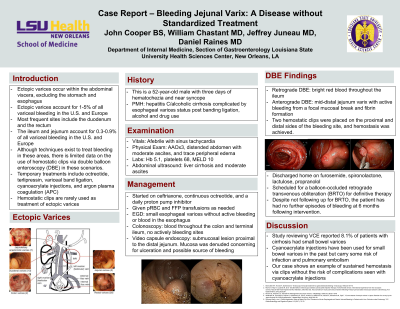Back


Poster Session C - Monday Afternoon
Category: GI Bleeding
C0337 - Bleeding Jejunal Varix: A Disease Without Standardized Treatment
Monday, October 24, 2022
3:00 PM – 5:00 PM ET
Location: Crown Ballroom

Has Audio

John Cooper, BS
Louisiana State University Health and Sciences Center
Baton Rouge, LA
Presenting Author(s)
John Cooper, BS1, William Chastant, MD2, Jeffrey Juneau, MD1, Daniel Raines, MD3
1Louisiana State University Health and Sciences Center, New Orleans, LA; 2LSUHSC, New Orleans, LA; 3LSU Health Sciences Center, New Orleans, LA
Introduction: Varices occurring within any of the abdominal viscera, excluding the esophagus and stomach, are referred to as ectopic varices. Less common sites of ectopic variceal bleeding are the ileum and jejunum. Although techniques exist to treat bleeding in these areas, there is limited data on the use of hemostatic clips via double balloon enteroscopy (DBE) in these scenarios.
Case Description/Methods: 52-year-old male with a history of hepatitis C/alcoholic cirrhosis complicated by esophageal varices status post banding ligation presented with three days of hematochezia and near syncope. He had a distended abdomen with moderate ascites, and trace peripheral edema. Lab studies revealed anemic to 5.1 g/dL, thrombocytopenic to 68/μL, and a Model for End-Stage Liver Disease (MELD) score of 10. Abdominal ultrasound revealed cirrhosis and moderate ascites.
Esophagogastroduodenoscopy revealed small esophageal varices without active bleeding. Colonoscopy showed blood throughout the colon and terminal ileum without active bleeding. Video capsule endoscopy revealed a submucosal lesion with prolonged pill retention proximal to the distal jejunal lesion. The mucosa on the lesion was denuded concerning for ulceration and a possible source of bleeding (Figure 1).
The patient underwent retrograde DBE which revealed bright red blood throughout the ileum. Anterograde DBE revealed a mid-distal jejunum varix with active bleeding from a focal mucosal break and fibrin formation (Figure 2). Two hemostatic clips were placed on the proximal and distal sides of the bleeding site, and hemostasis was achieved (Figure 3).
He was discharged and was scheduled for a balloon-occluded retrograde transvenous obliteration (BRTO) for definitive therapy. Despite not following up for BRTO, the patient has had no further episodes of bleeding at 6 months following intervention.
Discussion: In treating distal jejunal and ileal variceal bleeding, the primary concern is accessing those sites. Standard endoscopy is commonly insufficient, so DBE has utility in these cases. In our case, the patient’s varix was treated by hemostatic clips placed to decompress the varix at its site of bleeding using mechanical force. This technique was done as a temporary measure with the intent of definitive therapy by means of BRTO. This case demonstrates not only the utility of DBE in diagnosing and accessing small bowel varices, it also provides an additional means of treatment by the use of hemostatic clips as a bridge to more definitive therapy.

Disclosures:
John Cooper, BS1, William Chastant, MD2, Jeffrey Juneau, MD1, Daniel Raines, MD3. C0337 - Bleeding Jejunal Varix: A Disease Without Standardized Treatment, ACG 2022 Annual Scientific Meeting Abstracts. Charlotte, NC: American College of Gastroenterology.
1Louisiana State University Health and Sciences Center, New Orleans, LA; 2LSUHSC, New Orleans, LA; 3LSU Health Sciences Center, New Orleans, LA
Introduction: Varices occurring within any of the abdominal viscera, excluding the esophagus and stomach, are referred to as ectopic varices. Less common sites of ectopic variceal bleeding are the ileum and jejunum. Although techniques exist to treat bleeding in these areas, there is limited data on the use of hemostatic clips via double balloon enteroscopy (DBE) in these scenarios.
Case Description/Methods: 52-year-old male with a history of hepatitis C/alcoholic cirrhosis complicated by esophageal varices status post banding ligation presented with three days of hematochezia and near syncope. He had a distended abdomen with moderate ascites, and trace peripheral edema. Lab studies revealed anemic to 5.1 g/dL, thrombocytopenic to 68/μL, and a Model for End-Stage Liver Disease (MELD) score of 10. Abdominal ultrasound revealed cirrhosis and moderate ascites.
Esophagogastroduodenoscopy revealed small esophageal varices without active bleeding. Colonoscopy showed blood throughout the colon and terminal ileum without active bleeding. Video capsule endoscopy revealed a submucosal lesion with prolonged pill retention proximal to the distal jejunal lesion. The mucosa on the lesion was denuded concerning for ulceration and a possible source of bleeding (Figure 1).
The patient underwent retrograde DBE which revealed bright red blood throughout the ileum. Anterograde DBE revealed a mid-distal jejunum varix with active bleeding from a focal mucosal break and fibrin formation (Figure 2). Two hemostatic clips were placed on the proximal and distal sides of the bleeding site, and hemostasis was achieved (Figure 3).
He was discharged and was scheduled for a balloon-occluded retrograde transvenous obliteration (BRTO) for definitive therapy. Despite not following up for BRTO, the patient has had no further episodes of bleeding at 6 months following intervention.
Discussion: In treating distal jejunal and ileal variceal bleeding, the primary concern is accessing those sites. Standard endoscopy is commonly insufficient, so DBE has utility in these cases. In our case, the patient’s varix was treated by hemostatic clips placed to decompress the varix at its site of bleeding using mechanical force. This technique was done as a temporary measure with the intent of definitive therapy by means of BRTO. This case demonstrates not only the utility of DBE in diagnosing and accessing small bowel varices, it also provides an additional means of treatment by the use of hemostatic clips as a bridge to more definitive therapy.

Figure: Figure 1 (left), Figure 2 (middle), Figure 3 (right)
Disclosures:
John Cooper indicated no relevant financial relationships.
William Chastant indicated no relevant financial relationships.
Jeffrey Juneau indicated no relevant financial relationships.
Daniel Raines indicated no relevant financial relationships.
John Cooper, BS1, William Chastant, MD2, Jeffrey Juneau, MD1, Daniel Raines, MD3. C0337 - Bleeding Jejunal Varix: A Disease Without Standardized Treatment, ACG 2022 Annual Scientific Meeting Abstracts. Charlotte, NC: American College of Gastroenterology.
